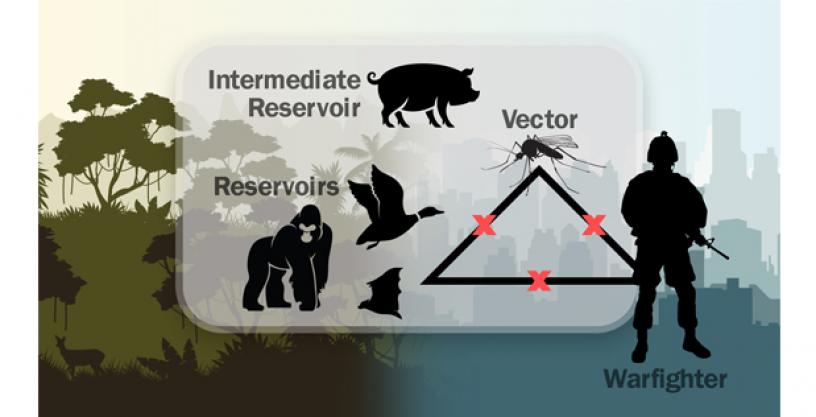
PREEMPT aims to predict and contain viral mutations to prevent cross-species transmission of disease from animals and insects to humans
Jan 4, 2018
Avian influenza (H7N9). MERS coronavirus. Ebola. Hepatitis E. Yellow Fever. Lassa. Zika. When you consider the viral infectious diseases that emerged and reemerged around the world in 2017 alone, what many of them have in common is that they originated in animals and spilled over into humans after a series of mutations that enable the pathogens to jump species.
The U.S. Department of Defense has a vested interest in outmaneuvering infectious disease. Military service members are called upon to operate virtually anywhere in the world, often on short notice, and the locations to which they deploy frequently lack the robust public health infrastructure to identify and contain the spread of new viral infectious diseases. At the same time, numerous trends including increased interactions between human, animal, and insect populations due to globalization, densification of livestock production, and rising human encroachment into animal habitats have increased the threat of novel pathogens in regions where troops, humanitarian workers, and peacekeepers tend to deploy.
A new DARPA program called Preventing Emerging Pathogenic Threats, or PREEMPT, seeks to support military readiness by going after new viral infectious diseases at the source, animal reservoirs—the species in which a pathogen lives, multiplies, and potentially evolves into a strain that can threaten humans. PREEMPT aims to advance understanding of viruses and their interaction with animals, insects, and humans, and deliver new, proactive interventions to reduce the risk from emerging and reemerging pathogens.
“Despite global biosurveillance efforts, viral outbreaks continue to outpace medical preparedness. That means that in volunteering to be the first ones into harm’s way, our Service members can quite literally be among the first people exposed to emerging infectious diseases,” said Jim Gimlett, the PREEMPT program manager. “DARPA wants to reorient preparedness efforts to make them more proactive, so that instead of only modeling the trajectory of an epidemic as it spreads from human to human, we contain and suppress diseases in the animal species in which they originate before they can make a jump into people.”
PREEMPT will have two technical thrusts: development of multiscale models and test beds to quantify the imminent emergence and reemergence of human pathogens; and development of new, scalable approaches to preventing pathogen spillover and transmission from animals and vectors into humans.
Understanding how viruses evolve within a species will be a core area of research. That evolutionary process contains natural bottlenecks that could be exploited to impede dangerous mutations. PREEMPT will seek to identify these opportunities for intervention by modeling the factors that enable species jump. Researchers on the program will be required to conduct field surveillance of animal and insect species in high-risk areas around the world; generate data in lab testing and sequence viruses as they evolve; analyze the jump risk by weighing factors such as past known jump events, ecology, seasonal variants, and geospatial data; and, finally, validate models using simulated natural environments.
New proactive interventions will center on methods for disarming a virus before it can make a jump across species. PREEMPT aims to prevent transmission of virus from a reservoir species direct to humans, from a reservoir species to traditional vectors, such as mosquitos, that spread disease, and from a reservoir species to a species intermediate to humans—for example, from bats to pigs.
Successful interventions will be tailored to anticipated threats. For instance, if a single mutation is identified by models as high risk, an intervention might seek to prevent its entry into a new species by removing that specific mutation from the reservoir. Alternatively, if multiple potential threats are identified, an intervention could involve treating the entire animal reservoir to reduce viral load using tools such as anti-virals, vaccines, and interfering particles. Other forms of intervention might involve new approaches to suppressing the transmission of specific viruses by insect vectors. In all cases, researchers will need to develop scalable methods that can be readily deployed even in remote locations.
During the planned 3.5-year PREEMPT program, DARPA aims to identify signatures of viral fitness and the potential for spillover from one species to another; develop risk classifiers and predict pathways of viral adaptation; and test initial intervention approaches. By the end of the program, DARPA seeks to demonstrate in controlled laboratory conditions the suppression of viral jump to a new species.
“If we are able to predict how viruses might mutate and spread, and take steps to prevent those mutations from impacting humans, then we’ll vastly diminish the possibility of future viral pandemics,” said Gimlett.
Although PREEMPT is a fundamental research program, DARPA is aware of biosafety and biosecurity sensitivities that could arise. The agency will work with external bioethics advisors to ensure efforts funded by the program adhere to regulations and ethical best practices. Proposers will also be required to address potential ethical, legal, and societal implications of the research.
DARPA will hold a Proposers Day on January 30, 2018, in Arlington, Virginia, to provide more information about PREEMPT and to answer questions from potential proposers. For details of the event, including registration requirements, visit: https://go.usa.gov/xnyzB. A full program description will be made available in a forthcoming Broad Agency Announcement.
Image caption: Viral infectious diseases often arise in animals. Over time, as the virus multiplies and mutates, variants can gain the ability to jump between species. Transmission can be direct from animal to human, from animal to “bridge” animal to human, or animal to vector to human. DARPA’s Preventing Emerging Pathogenic Threats program seeks to prevent these cross-species jumps by predicting viral evolution and transmission pathways and proactively intervening to prevent the jump to humans.# # #
Media with inquiries should contact DARPA Public Affairs at outreach@darpa.mil
Associated images posted on www.darpa.mil and video posted at www.youtube.com/darpatv may be reused according to the terms of the DARPA User Agreement, available here: http://go.usa.gov/cuTXR.
Tweet @darpa
